buffalo

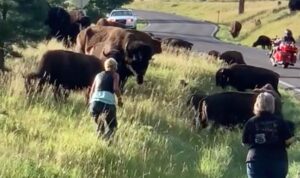 Every year, in areas where the buffalo roam, people get hurt. Most of the time, these attacks occur when people get too close to the buffalo. The big, clunky looking animals see like they would be very slow, and that can be deceiving for tourists who don’t know the reality concerning the buffalo. Every year, my husband, Bob Schulenberg and I find ourselves in a couple of places where the buffalo roam. We take a yearly trip to Thermopolis, Wyoming, and there is a buffalo reserve up there. We love to drive through it to try to get a glimpse of these magnificent animals. The buffalo up there are generally relaxing in the heat of the day when we go through, and they barely notice us at all, but then we don’t get out of the vehicle except on a trail that is located a way from the area the buffalo are. Nevertheless, if there were buffalo near the trail, we would pass on the trail.
Every year, in areas where the buffalo roam, people get hurt. Most of the time, these attacks occur when people get too close to the buffalo. The big, clunky looking animals see like they would be very slow, and that can be deceiving for tourists who don’t know the reality concerning the buffalo. Every year, my husband, Bob Schulenberg and I find ourselves in a couple of places where the buffalo roam. We take a yearly trip to Thermopolis, Wyoming, and there is a buffalo reserve up there. We love to drive through it to try to get a glimpse of these magnificent animals. The buffalo up there are generally relaxing in the heat of the day when we go through, and they barely notice us at all, but then we don’t get out of the vehicle except on a trail that is located a way from the area the buffalo are. Nevertheless, if there were buffalo near the trail, we would pass on the trail.
The other place we go each year is the Black Hills of South Dakota. The is a wildlife reserve there, and while  there have been years when we drove through and saw no buffalo, or saw some that were far away, there have been other years when we found ourselves sitting in the car for twenty or thirty minutes, while the buffalo stood in the road, crossed the road, and even walked very close to our car. In that situation, I find myself feeling very nervous for the people who were brave enough, or maybe crazy enough, to take that drive on a motorcycle. They are truly at the mercy of the buffalo, should they decide that they don’t like the look of the motorcycle. They have been known to “attack” a car or pickup, and I’m sure even a motorcycle, but I can tell you that the motorcycle would not fare as well as a car or truck. Most of the time, if you stay with your vehicle, you are pretty safe, even if the buffalo are on the run.
there have been years when we drove through and saw no buffalo, or saw some that were far away, there have been other years when we found ourselves sitting in the car for twenty or thirty minutes, while the buffalo stood in the road, crossed the road, and even walked very close to our car. In that situation, I find myself feeling very nervous for the people who were brave enough, or maybe crazy enough, to take that drive on a motorcycle. They are truly at the mercy of the buffalo, should they decide that they don’t like the look of the motorcycle. They have been known to “attack” a car or pickup, and I’m sure even a motorcycle, but I can tell you that the motorcycle would not fare as well as a car or truck. Most of the time, if you stay with your vehicle, you are pretty safe, even if the buffalo are on the run.
It is the people, and there is always a few, who just have to walk out to the buffalo to get a closer look, who get in trouble. We have watched people take that chance with their little ones, and even grandma using a walker to get close. If the buffalo became agitated and charged them, they are defenseless. Most people aren’t trying to feed the buffalo, but a number of people who have been gored and even killed were trying to take a selfie with the buffalo. The buffalo is an animal you certainly don’t want to turn your back on, and that is how a selfie is done. While it’s not funny exactly, we found a t-shirt this year in the Black Hills that said, “Do Not Pet The Fluffy Cows.” We have also seen signs that say the same thing. That is exactly what buffalo look like…a fluffy cow. I suppose that is why people assume they are tame. 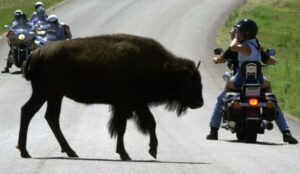
 No one really knows what might set a buffalo off, and sometimes it’s nothing at all. Maybe the buffalo is in a bad mood that day. They have been known to attack people who were in the places they should be, and minding their own business, but most often, buffalo attacks are caused when the buffalo is startled, or when people just get too close. This year, so far there have been three buffalo incidents. That’s tragic!! Please people, keep your distance and stay in your car.
No one really knows what might set a buffalo off, and sometimes it’s nothing at all. Maybe the buffalo is in a bad mood that day. They have been known to attack people who were in the places they should be, and minding their own business, but most often, buffalo attacks are caused when the buffalo is startled, or when people just get too close. This year, so far there have been three buffalo incidents. That’s tragic!! Please people, keep your distance and stay in your car.
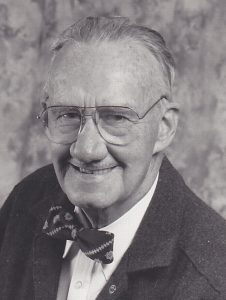 I am amazed at the number of inventions that have changed our world, but when they were invented, they were not what the inventor was trying to invent. Basically, while trying to make one thing, or repair something, the inventor stumbled on something else, and made an important discovery. Wilson Greatbatch was an inventor who had been quite successful, having 150 patents to his credit at the time of his accidental invention. Overall, in his lifetime, he was credited with an astonishing total of 325 patents for his many great brainstorms. Patents aside, Greatbatch will be best remembered for the invention and development of the first implantable pacemaker, a device which has improved, saved, and extended countless lives since its first use in 1960. Worldwide, approximately three million people currently benefit from Greatbatch’s discovery, with an additional 600,000 being implanted every year. It was not what he had be trying to make, however.
I am amazed at the number of inventions that have changed our world, but when they were invented, they were not what the inventor was trying to invent. Basically, while trying to make one thing, or repair something, the inventor stumbled on something else, and made an important discovery. Wilson Greatbatch was an inventor who had been quite successful, having 150 patents to his credit at the time of his accidental invention. Overall, in his lifetime, he was credited with an astonishing total of 325 patents for his many great brainstorms. Patents aside, Greatbatch will be best remembered for the invention and development of the first implantable pacemaker, a device which has improved, saved, and extended countless lives since its first use in 1960. Worldwide, approximately three million people currently benefit from Greatbatch’s discovery, with an additional 600,000 being implanted every year. It was not what he had be trying to make, however.
Wilson Greatbatch was born the son of British immigrants, Warren and Charlotte Greatbatch, in Buffalo, New York, in 1919. He attended school at West Seneca, New York. He had many interests, among which were the sea scouts and amateur radio. Greatbatch was just 16 years old when he received his amateur radio license. During World War II, Greatbatch served in the US Navy as an aviation chief radioman. He took advantage of the 1944 GI Bill to attend Cornell University, where he studied electrical engineering. He graduated in 1950 and began a teaching career at the University of Buffalo in 1952.
It was in 1956, while working at Buffalo, that he made his most important discovery. While it was his most important discovery, it was also the result of an error. Greatbatch had been working on a heart-rhythm recorder, but he mistakenly added an incorrect electronic component. The resulting device produced electrical pulses, instead of simply recording the rhythm. Recalling the event later, he said “I stared at the thing in  disbelief.” Greatbatch realized immediately that he had found a way to electrically simulate and stimulate a heartbeat. It was to become the most important invention of his life, and one that millions of people would be eternally grateful to him for “stumbling upon.”
disbelief.” Greatbatch realized immediately that he had found a way to electrically simulate and stimulate a heartbeat. It was to become the most important invention of his life, and one that millions of people would be eternally grateful to him for “stumbling upon.”
Of course, Greatbatch didn’t make the first pacemaker, but the prior models were bulky, external units which required the use of mains power, basically they had to be plugged into the wall…not conducive to leading an active life. At that time, battery technology was not advanced enough to allow the earlier units to be implanted, and my guess is that they were also big and bulky. Over the following two years Greatbatch managed to miniaturize and package the device so that it could be implanted. In May of 1958, he gave a successful demonstration of the invention in a dog. By 1960 the pacemaker had been implanted in the first human patient, a 77 year old man, who went on to live for another 18 months…not bad for a 77 year old heart patient.
A patent for the implantable pacemaker was granted in 1962, and in 1970 Greatbatch founded Wilson Greatbatch Ltd, which was later renamed now Greatbatch Inc, a company which continues to develop and manufacture lithium-based batteries for pacemakers. Greatbatch himself however, despite now having extensive offices and laboratory facilities, preferred to continue his research at his home garage workshop. He was always a tinkerer, and as he said in an interview with the Associated Press, “Nine things out of 10 don’t work, but the 10th one will pay for the other nine”. When he was asked about the change in quality of life that the pacemaker brought, Greatbatch told his local Buffalo newspaper in 1984, “I think one of my first and most gratifying realizations of what a pacemaker could do was in observing the reactions of elderly people to their grandchildren. People with heart disease generally don’t have enough blood supply to their brains and couldn’t respond before to the bantering of kids.”
Greatbatch was presented with many awards during his lifetime. In 1983 the National Society of Professional 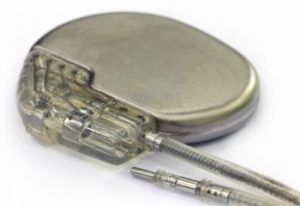 Engineers selected the pacemaker as one of the greatest contributions to society of the previous 50 years. In 1998 Greatbatch was inducted into the National Inventors’ Hall of Fame in Akron, Ohio, alongside his hero Thomas Edison. This was followed, in 2001, by the granting of the highest honor from the National Academy of Engineering, shared with his peer Earl Bakken, who invented the external pacemaker. Greatbatch’s autobiographical account of his discovery, The Making of the Pacemaker: Celebrating a Lifesaving Invention, was published in 2000. Wilson Greatbatch died at the good old age of 92 on September 27, 2011. Greatbatch served as an elder at Clarence Presbyterian Church, where he also sang in the church choir and taught Sunday school.
Engineers selected the pacemaker as one of the greatest contributions to society of the previous 50 years. In 1998 Greatbatch was inducted into the National Inventors’ Hall of Fame in Akron, Ohio, alongside his hero Thomas Edison. This was followed, in 2001, by the granting of the highest honor from the National Academy of Engineering, shared with his peer Earl Bakken, who invented the external pacemaker. Greatbatch’s autobiographical account of his discovery, The Making of the Pacemaker: Celebrating a Lifesaving Invention, was published in 2000. Wilson Greatbatch died at the good old age of 92 on September 27, 2011. Greatbatch served as an elder at Clarence Presbyterian Church, where he also sang in the church choir and taught Sunday school.
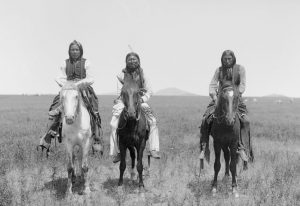 The battle for lands owned, desired, or presumed owned, is one that has raged in the United States for many, many years. When the pilgrims first came to the new world, it did not seem like a problem to the Native Americans, but as more and more “White Men” came, the Native Americans could see the writing on the wall. so to speak. They knew that their wide open spaces were in jeopardy, and they were determined not to lose the battle for their most prized possession…land. In the 18th and 19th centuries settlers from Europe moved westward across America in a steady wave. The migration overwhelmed ancient tribes like the Iroquois, the Cherokee, and the Shawnee. But when the settlers reached Texas and the lands of the Comanche, the migration stopped in it’s tracks. Many of the Indians back then were somewhat like the settlers. They had their villages, and they stayed in one place, or moved slowly from one place to another. The Comanche were just like that, until the horse arrived in North America. But the Comanche adapted to the horse like no other Native American group. They became nomads, following the buffalo, and as they exploded across the Texas plains, they virtually wiped out the Apache. Their enormous horse herds were legendary, as were their riding skills. While the Cheyenne and Sioux would dismount before battles, the Comanche mastered the art of fighting on horseback. They planted no crops, built no settlements, and shunned complex ritual or religion. The name “Comanche” was given to them by the Utes. It means “enemies.”
The battle for lands owned, desired, or presumed owned, is one that has raged in the United States for many, many years. When the pilgrims first came to the new world, it did not seem like a problem to the Native Americans, but as more and more “White Men” came, the Native Americans could see the writing on the wall. so to speak. They knew that their wide open spaces were in jeopardy, and they were determined not to lose the battle for their most prized possession…land. In the 18th and 19th centuries settlers from Europe moved westward across America in a steady wave. The migration overwhelmed ancient tribes like the Iroquois, the Cherokee, and the Shawnee. But when the settlers reached Texas and the lands of the Comanche, the migration stopped in it’s tracks. Many of the Indians back then were somewhat like the settlers. They had their villages, and they stayed in one place, or moved slowly from one place to another. The Comanche were just like that, until the horse arrived in North America. But the Comanche adapted to the horse like no other Native American group. They became nomads, following the buffalo, and as they exploded across the Texas plains, they virtually wiped out the Apache. Their enormous horse herds were legendary, as were their riding skills. While the Cheyenne and Sioux would dismount before battles, the Comanche mastered the art of fighting on horseback. They planted no crops, built no settlements, and shunned complex ritual or religion. The name “Comanche” was given to them by the Utes. It means “enemies.” 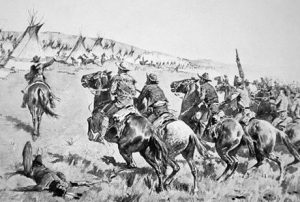
Unfortunately for the Comanche, they were no match for the settlers. After being beaten early on, the Comanche avoided direct conflict for the most part. They preferred to attack undefended farmhouses, slaughtering the inhabitants. It worked, the settlers were too afraid to travel into Comanche territory, and European expansion almost came to a screeching halt. In 1858, after a particularly bloody year, the Texas Rangers were ordered to take care of the Comanche. The empire of the Texas plains was a brutal and unchanging grassland of deadly heat and vast wildfires. No European had traveled very far into the territory, but now the Rangers intended to do just that. They were accompanied by a group of Tonkawas, a local tribe hated by other Native Americans for their cannibalism. The Comanche slaughtered the Tonkawas whenever possible, and the survivors were out for revenge. Together, the Rangers and the Tonkawas traveled for weeks, even fording stretches of pure quicksand, until they discovered a huge Comanche camp stretching along a creek in the Antelope Hills. The Comanche sprang onto their horses, but it was too late. They never expected to be attacked in the heart of the Comancheria and were in no position to fight. It looked as if all was lost, and indeed it was, but they did not know that yet.

Suddenly, Chief Iron Jacket rode out of the chaos. His true name was Pobishequasso, but he was known as Iron Jacket for his ancient coat of Spanish armor, a family heirloom looted from the corpse of some unlucky conquistador. He exhaled great breaths of air as he rode toward the Rangers, working his medicine, which was said to blow bullets off target. The Rangers and the Tonkawas opened fire, but Iron Jacket kept coming. The bullets seemed to bounce off him, and for a moment, it seemed that he was unstoppable. Then, the magic ended. A hail of rifle fire cut down his horse, and a second volley finished Pobishequasso. His followers…armed only with lances and ancient muskets..fled, pursued by the Rangers, who picked off at least 76 of them. In the years that followed, the settlers became bolder, launching numerous raids into the Comancheria. Iron Jacket’s rusting armor was broken up for souvenirs. The reign of the Comanche was over.
 We’ve all eaten them…unless you are allergic to chicken that is. Hot wings. They grace just about every Super Bowl party food table, or any other football gathering for that matter, but where did the idea come from? Well, they have been around longer than I thought they had. I think that many people used the chicken wings for soup stock, and some restaurants even threw it away. Now my husband likes the wings, but much of the time, I find them a waste of time, unless they are in the form of hot wings. I think a lot of people would agree with my point of view.
We’ve all eaten them…unless you are allergic to chicken that is. Hot wings. They grace just about every Super Bowl party food table, or any other football gathering for that matter, but where did the idea come from? Well, they have been around longer than I thought they had. I think that many people used the chicken wings for soup stock, and some restaurants even threw it away. Now my husband likes the wings, but much of the time, I find them a waste of time, unless they are in the form of hot wings. I think a lot of people would agree with my point of view.
Accounts of the invention of hot wings, or Buffalo Wings as they are often called, vary, but apparently the one that has been most accepted is that they were invented by Teressa Bellissimo, who along with her husband Frank, owned the Anchor Bar in Buffalo, New York. When the Bellissmo’s son, Dominic made a surprise visit from college with several friends, Teressa needed a fast and easy snack to present to all of her guests. It was then that she came up with the idea of deep frying chicken wings and tossing them in cayenne hot sauce. Apparently, the wings were a big hit. However, when a long article was written about the Anchor Bar, no mention was made of the Buffalo Wings.
 Another man, John Young also claims to have made the first Buffalo Wings covered in a special Mambo Sauce in his Buffalo restaurant in the 1960s. Young’s wings were breaded, unlike the hot wings of today. Young registered his restaurant as John Young’s Wings ‘n Things, at the county courthouse in Buffalo before leaving the area in 1970. The Bellissimo family claims that the Young Buffalo Wings used the same sauce as the Bellissimo Buffalo Wings. I suppose it really doesn’t matter who invented them, or what sauce is used, especially since there are multiple flavors now. The main thing is that pretty much everyone has had and loves Buffalo Wings. In fact, they have become a party mainstay since the 1960s.
Another man, John Young also claims to have made the first Buffalo Wings covered in a special Mambo Sauce in his Buffalo restaurant in the 1960s. Young’s wings were breaded, unlike the hot wings of today. Young registered his restaurant as John Young’s Wings ‘n Things, at the county courthouse in Buffalo before leaving the area in 1970. The Bellissimo family claims that the Young Buffalo Wings used the same sauce as the Bellissimo Buffalo Wings. I suppose it really doesn’t matter who invented them, or what sauce is used, especially since there are multiple flavors now. The main thing is that pretty much everyone has had and loves Buffalo Wings. In fact, they have become a party mainstay since the 1960s.

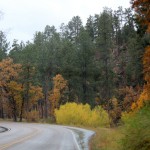 Last Sunday, while on a trip to Hot Springs, South Dakota to hike the Mickelson Trail, Bob and I found ourselves sidelined due to rain. We sat around the hotel for several hours…until Bob decided that he had cabin fever. So we decided to go for a drive. I had driven this road on my trip to Wisconsin with my mom and sister, Cheryl. The road took us out the east side of Hot Springs, and then toward Rapid City. We went a ways and then turned toward Custer. The drive was beautiful with all the fall colors. It would eventually connect us with Custer State Park, but since we weren’t going to the Needles or the Wildlife Loop, we didn’t have to pay the fee.
Last Sunday, while on a trip to Hot Springs, South Dakota to hike the Mickelson Trail, Bob and I found ourselves sidelined due to rain. We sat around the hotel for several hours…until Bob decided that he had cabin fever. So we decided to go for a drive. I had driven this road on my trip to Wisconsin with my mom and sister, Cheryl. The road took us out the east side of Hot Springs, and then toward Rapid City. We went a ways and then turned toward Custer. The drive was beautiful with all the fall colors. It would eventually connect us with Custer State Park, but since we weren’t going to the Needles or the Wildlife Loop, we didn’t have to pay the fee.
As I said, the drive was nice, even in the rain and the scenery was beautiful, but one thing we started to notice…over and over, was a lot of turkeys. It felt like we had stumbled upon Turkey Central. They were in the farmers fields, by the side of the road, and even walking down the road. And they weren’t one bit afraid of our car either. In fact, they completely ignored us and our car. They moved only when they wanted to move. It occurs to me that these turkeys are quite used to all this traffic, and they might even like it. It also occurs to me that these turkeys are most likely bound for Thanksgiving and Christmas tables in the area. As we drove, we slowly went beyond all the turkeys, but it was too late by then, because I had already decided that we had just traveled through Turkey Central. It was as if they owned that stretch of road…or at least thought they did.

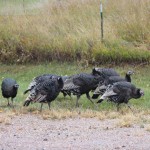 The rest of our drive was fairly void of wildlife, and I went back to looking at the beautiful colors. My only wish would be that our area might have a few more red fall colors than it currently has…and that there might be a few more of the various kinds of wildlife. We did happen to see a few buffalo, but they were on someone’s ranch, so I suppose they aren’t wild…not that I intend to find out. For me, the turkeys were really the highlight of the drive. They just acted so bold and brave…never even taking notice of us at all. I think it was a very interesting drive through Turkey Central, indeed.
The rest of our drive was fairly void of wildlife, and I went back to looking at the beautiful colors. My only wish would be that our area might have a few more red fall colors than it currently has…and that there might be a few more of the various kinds of wildlife. We did happen to see a few buffalo, but they were on someone’s ranch, so I suppose they aren’t wild…not that I intend to find out. For me, the turkeys were really the highlight of the drive. They just acted so bold and brave…never even taking notice of us at all. I think it was a very interesting drive through Turkey Central, indeed.
 Every year, usually around the first of March, but a little later this year because of spring break, Bob and I take a three day weekend and spend it in Thermopolis to celebrate our wedding anniversary, which is March 1st. It is our way of renewing our relationship. We renewed our vows on our 25th anniversary, when we took a cruise, and that was a beautiful time, but these mini renewing events are very much a blessing too. There is no real itinerary, other than a lovely prime rib dinner and multiple relaxing sessions in tho hot tub. If the weather if nice we go for long walks along the river and up to the hot springs, but if not, we might just relax around the motel room. We usually drive through the buffalo reserve before leaving, but rarely see what we saw this time…6 buffalo right on the road. We thought for a moment they were going to ram our car, but they decided that was too much work
Every year, usually around the first of March, but a little later this year because of spring break, Bob and I take a three day weekend and spend it in Thermopolis to celebrate our wedding anniversary, which is March 1st. It is our way of renewing our relationship. We renewed our vows on our 25th anniversary, when we took a cruise, and that was a beautiful time, but these mini renewing events are very much a blessing too. There is no real itinerary, other than a lovely prime rib dinner and multiple relaxing sessions in tho hot tub. If the weather if nice we go for long walks along the river and up to the hot springs, but if not, we might just relax around the motel room. We usually drive through the buffalo reserve before leaving, but rarely see what we saw this time…6 buffalo right on the road. We thought for a moment they were going to ram our car, but they decided that was too much work
We did take one walk this year, but it was pretty cold, so it wasn’t really the highlight of the trip, but then we were both pretty tired this year, so relaxing in the room 
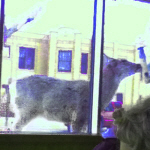 watching television was ok too. When we went to dinner, the deer came out to eat the corn provided for them right by the windows of the restaurant…always a highlight of the trip. It is always amazing to me that the deer are unafraid of the people in the restaurant…even when they are close enough to touch each other were it not for the glass. This year too, we got to watch a couple of little girls get to feed the deer their corn. I’m sure that was a once in a lifetime event for the girls, and we enjoyed watching it too. Dinner was wonderful as usual, and we always enjoy the Safari Club. The animals on display there were mostly shot by the owner, some before they were listed as endangered. Most
watching television was ok too. When we went to dinner, the deer came out to eat the corn provided for them right by the windows of the restaurant…always a highlight of the trip. It is always amazing to me that the deer are unafraid of the people in the restaurant…even when they are close enough to touch each other were it not for the glass. This year too, we got to watch a couple of little girls get to feed the deer their corn. I’m sure that was a once in a lifetime event for the girls, and we enjoyed watching it too. Dinner was wonderful as usual, and we always enjoy the Safari Club. The animals on display there were mostly shot by the owner, some before they were listed as endangered. Most  of his hunting now involves shooting the animals with a tranquilizer gun. Taking pictures of his kill, having a veterinarian check them over and treat anything that needs treating, and then he releases them back into the wild. I think that is an awesome thing to do.
of his hunting now involves shooting the animals with a tranquilizer gun. Taking pictures of his kill, having a veterinarian check them over and treat anything that needs treating, and then he releases them back into the wild. I think that is an awesome thing to do.
All too soon, our anniversary trip is over for another year, but we always come away from these trip closer together than we were before. I think every couple needs those little romantic trips periodically. It reminds you why you are in this marriage, after all. It puts you in tune with each other, and for us it confirms the love we always knew we had.

